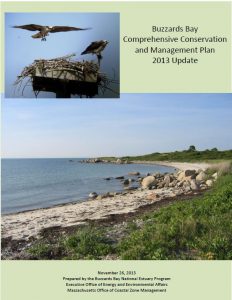2013 CCMP, Action Plan 8:
Restoring Migratory Fish Passage and Populations
About the new Buzzards Bay CCMP Action Plans
The Buzzards Bay Comprehensive Conservation and Management Plan (CCMP) was updated in November 2013 to reflect the great progress achieved since the original CCMP was finalized. You can download the entire document (buzzards-bay-ccmp-2013-update.pdf) or just this action plan Restoring Migratory Fish Passage and Populations.
Restoring Migratory Fish Passage
Problem
In the Buzzards Bay watershed, there are more than 8,000 acres of ponds and hundreds of stream miles. Prior to colonial settlements most of these ponds and streams were likely important habitat for fish species that spent portions of their life cycle in both fresh and marine waters. These diadromous species include river herring (bluebacks and alewife), historically the most predominate species, in many rivers. Other locally important diadromous fish are the eel, white perch, rainbow smelt, and sea run brook trout. All these species have declined dramatically in the Buzzards Bay watershed during the past 200 years. Historically, the declines were largely caused by river obstructions, particularly the widespread construction of milldams during the 19th century, but culvert installation, channelization of streams, loss of bordering tree and shrub vegetation, and pollution and sediment discharges have all been contributing factors. The loss of suitable river spawning habitat (gravel bot-tom streams with fast moving cool water, for example) has affected many species. Water diversion and pumping for agricultural purposes can impede migrations and result in juvenile fish mortality.
All these species will benefit most appreciably from the elimination of obstructions to migration and the creation of more suitable river and stream spawning habitat. In many cases, dam removal may be the best management option, in other cases, new fish ladder installations may be the only practical solution. Improved water management practices by cranberry growers, and preventing excessive drawdowns by municipal water supplies during drought years is important to avoid placing adult and juvenile populations at risk.
In the case of river herring, while there were some modest improvements in certain populations toward the end of the twentieth century, offshore fishing pressures, and bycatch takings have resulted in new dramatic declines. Restoration of river herring populations will require rigorous controls of offshore catch.
Goals
Goal 8.1. Ensure that the migration of fish species between salt and fresh water is unimpeded.
Goal 8.2. To restore degraded stream habitat and stream functions to ensure the diversity and abundance of fish in Buzzards Bay streams.
Goal 8.3. To manage fishing pressures on anadromous fish populations to ensure the fish harvest and bycatch are sustainable.
Objectives
Objective 8.1. Ensure adequate funding of state fisheries restoration programs.
Objective 8.2. Ensure that local, state, and federal fisheries regulators manage better the catch and bycatch of river herring and other diadromous fish to promote their recovery and population sustainability.
Objective 8.3. Improve passageways and remove impediments and obstructions to fish migration.
Objective 8.4. Ensure adequate stream flow for fish migration.
Approaches
State and local managers must identify and restore priority fish habitat sites and remove obstructions to fish migration. Many smaller herring runs need to be elevated as a priority for restoration because of their cumulative benefits. A special focus of the state and towns should be a coordinated restoration of fish habitat along the entire length of the Weweantic River. While these river restoration efforts are underway, the National Marine Fisheries Service, Regional Fisheries Management Councils, and the Atlantic States Marine Fisheries Commission should limit the catch and bycatch of river herring in offshore waters and take other measures. DEP could require, as a condition in all state water withdrawal permits, that there is adequate flow in rivers during adult and juvenile migration periods for species in the stream. Permittees should always be required to use appropriate screening of water withdrawal intakes to prevent stranding, mutilation, entrainment, or impingement of young herring.
Costs and Financing
Developing and implementing designs to repair fish passageway structures in the watershed, and to remove obstacles, including dams, may cost millions. Federal grants can cover some of these costs but state and local government may need to provide additional funding for natural resource staff. Regulatory solutions have negligible costs to government. The installation of a fish counter on a particular stream may cost $10,000 or more.
Measuring Success
The number of restoration efforts undertaken, or quantifying the number of upstream or downstream river miles or pond acres newly accessible or restored are easily tracked. Different management actions may benefit some species and not others. Ultimately, the size of the fish species population will be the best measure of success and can be determined through automated fish counters, observations by volunteers, direct capture, or through catch, mark, and release programs.
